This is the complete guide on how to cook butternut squash 5 different ways: roasted, boiled, in the microwave, in a crockpot, and in an Instant Pot. In addition, find out how to peel and cut it easily (halved, quartered, or cubed) to prepare side dishes, soups, or to make bread and pies. It is just as easy as peeling pumpkin!
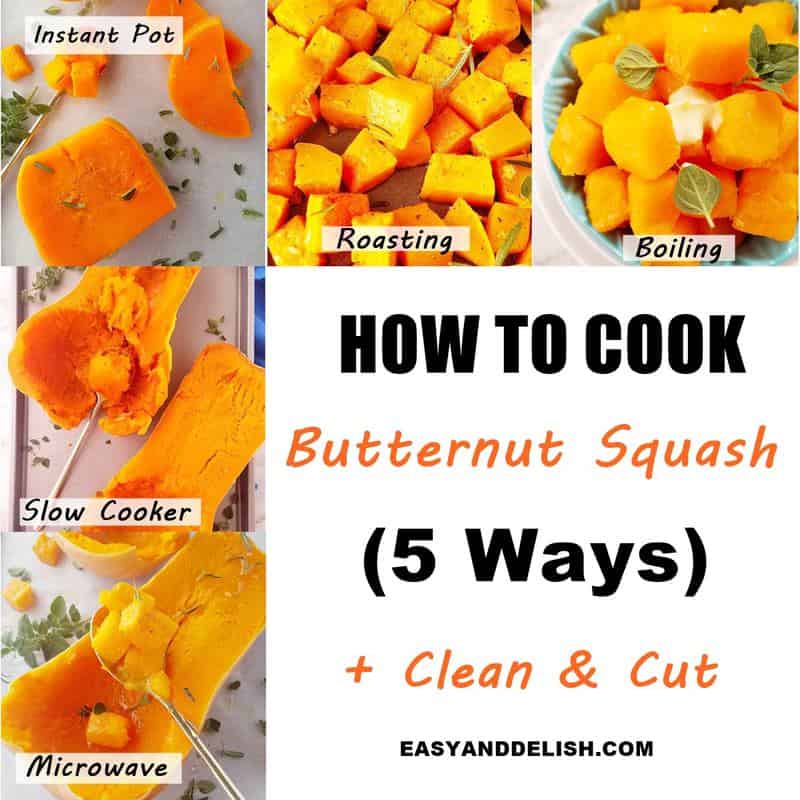
Table of Contents
- 1 What is butternut squash?
- 2 Is it healthy?
- 3 How to Buy Butternut Squash
- 4 How to peel and cut Butternut squash
- 5 How long to roast butternut squash?
- 6 How to cook butternut squash (5 ways)
- 7 Can You Eat the Skin?
- 8 What to serve with cooked squash
- 9 Storage
- 10 For More Side Dish Recipes:
- 11 How to cook butternut squash (5 ways)
What is butternut squash?
Butternut squash, also known as gramma or butternut pumpkin, is actually a fruit -- although many think it is a vegetable. This winter squash grows on a vine and has a sweet and nutty taste, similar to a pumpkin.
It has a long shape and orange starchy pulp with a tan-yellow skin. You can cut and peel and then cook butternut squash in many different ways: boiled, roasted, sautéed, steamed, roasted, stewed, and even grilled. It can be cut into different shapes and sizes too!
If you are on a gluten-free diet, you may enjoy cooking butternut squash noodles. You can even purée it and make a butternut squash mac and cheese. The cooked squash is mixed into the cheese sauce and tossed with the cooked macaroni.
As you can see, it is a versatile ingredient that goes well in both savory and sweet dishes.
Find out what butternut squash tastes like !
Is it healthy?
Yes! Butternut squash is a good source of fiber, vitamin A and C, magnesium, and potassium. It has about 16 g of carbs per cup and so is not really keto-friendly. If you are on a keto diet, you may consume it, but in low amounts.
How to Buy Butternut Squash
Choose a butternut squash that has a tan or beige color and no deep cuts or bruises. It should feel heavy for its size!
How to peel and cut Butternut squash
Is peeling butternut squash necessary? Well, it depends on how you plan to cut and cook it. If you want to scoop out the flesh or pulp to make a mashed squash for example, you can cook it whole in the microwave after making some slits (about ¼-inch deep) in the flesh to vent. Then, cut in half, remove the seeds, and scoop out the flesh. In this case, it is not necessary, but if you wish to cut it into cubes to roast and serve as a side dish, peeling is needed.
Preparing butternut squash may seem intimidating.
But I will show you how simple it is to peel and cut butternut squash, as follows:
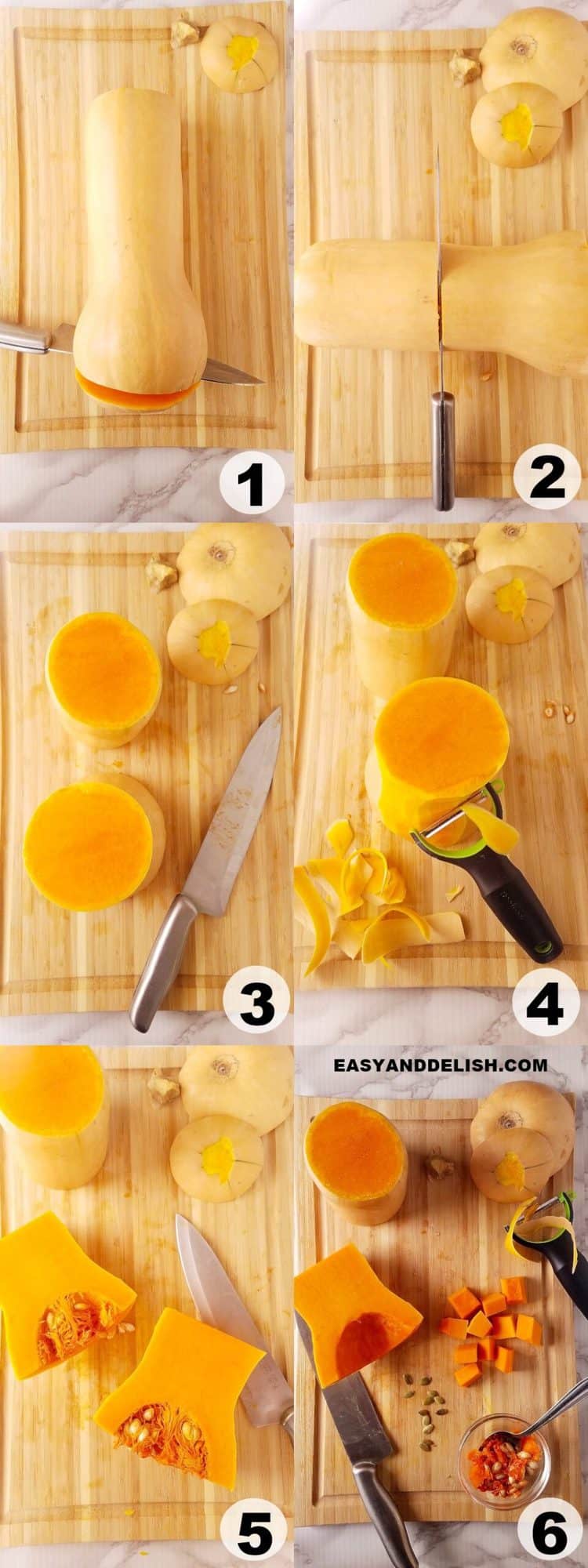
- Wash squash thoroughly using a vegetable brush. This will help to avoid contaminating the vegetable peeler! Then, pat dry to keep the peeling process from getting slippery.
- Next, cut off the ends and slice the squash in half crosswise. SEE PICS. 1 & 2 This will allow you to place each half upright in a steady position on the cutting board. SEE PIC. 3
- Using a vegetable peeler or a sharp knife, peel off all the skin. SEE PIC. 4
- Cut halved squash into quarters. SEE PIC. 5 Then, remove both the seeds and attached strings using a spoon or ice cream scoop.
- At this point, you may cut the squash into slices or into ¾ to 1-inch cubes. Or you can cook the quarters in the Instant Pot, for example. SEE PIC. 6
How long to roast butternut squash?
As you will see below, it takes around 35-40 minutes at 400 degrees F (200 degrees C) in a preheated oven to roast squash. Time may vary depending on oven temperature variations, altitude, and the size of the squash cubes.
How to cook butternut squash (5 ways)
Roasting:
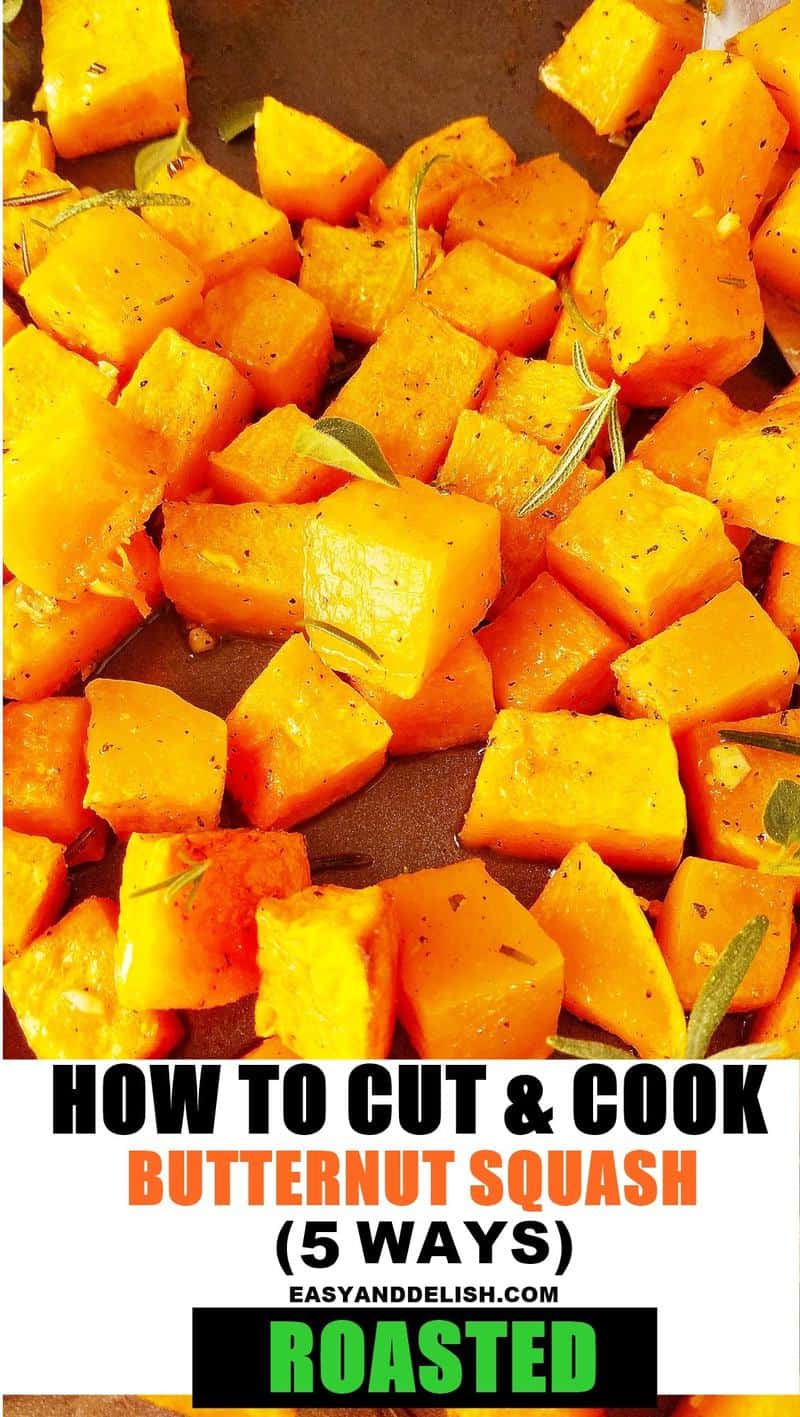
- Preheat oven to 400 F (200 C). Wash squash with a brush and pat dry.
- Cut off ends and then cut in half crosswise. Place halves upright and peel the skin off with a vegetable peeler or a sharp knife.
- Cut squash into quarters and remove both the seeds and strings using a spoon.
- Cut into ¾ to 1–inch cubes. Place them into a bowl and mix with olive oil, garlic, rosemary, and salt and pepper until coated.
- Spread mixture into a large baking sheet (preferably lined with foil for easy cleaning).
- Roast for about 35-40 minutes or until fork-tender and caramelized.
Boiling:
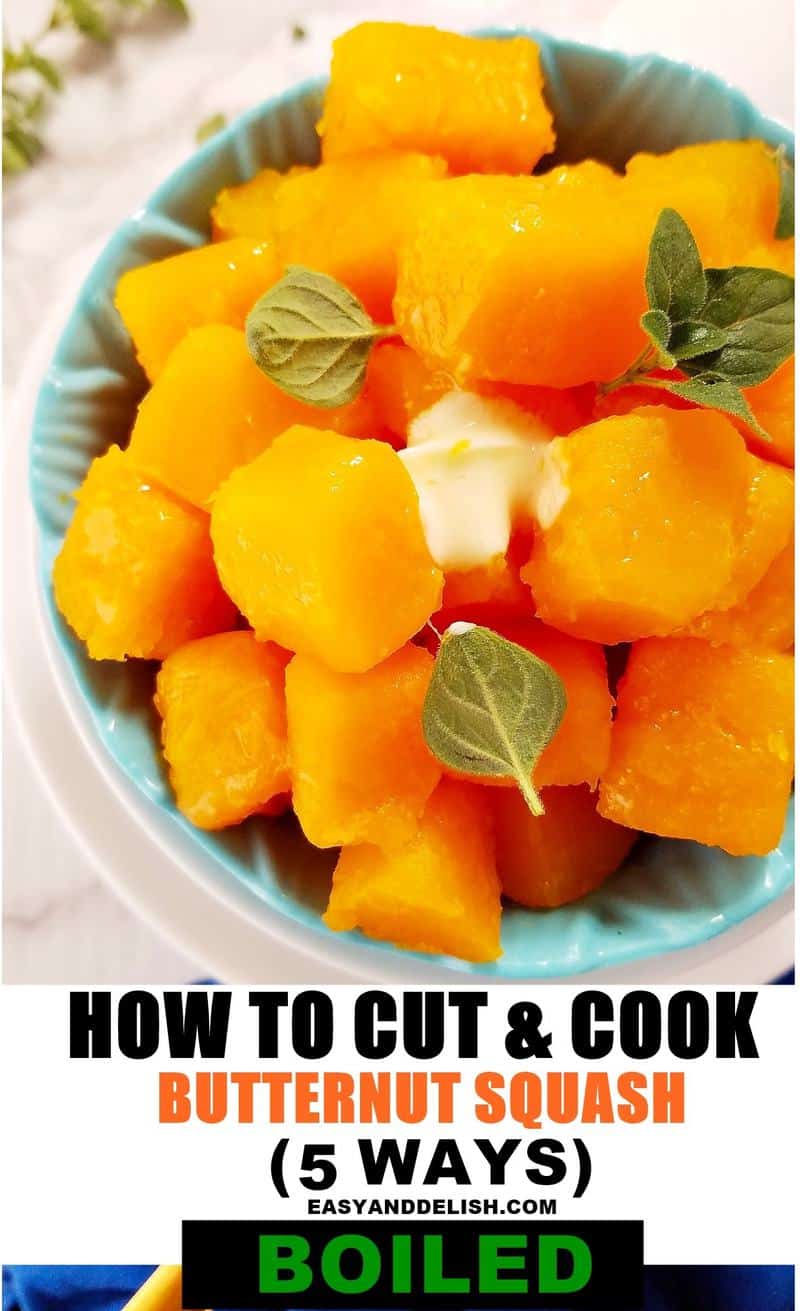
- Wash squash with a brush and pat dry. Cut off ends and then cut in half crosswise. Place halves upright and peel the skin off with a vegetable peeler or a sharp knife.
- Cut squash into quarters and remove both the seeds and strings using a spoon. Cut into ¾ to 1–inch cubes.
- Place squash in a pot and fill with enough water to cover by 1-2 inches above the squash. Season with salt and boil over high heat for about 12-15 minutes or until fork-tender.
- Drain or remove cooked squash with a slotted spoon. You may serve with butter while still hot or with a hint of extra virgin olive oil.
In the crockpot:
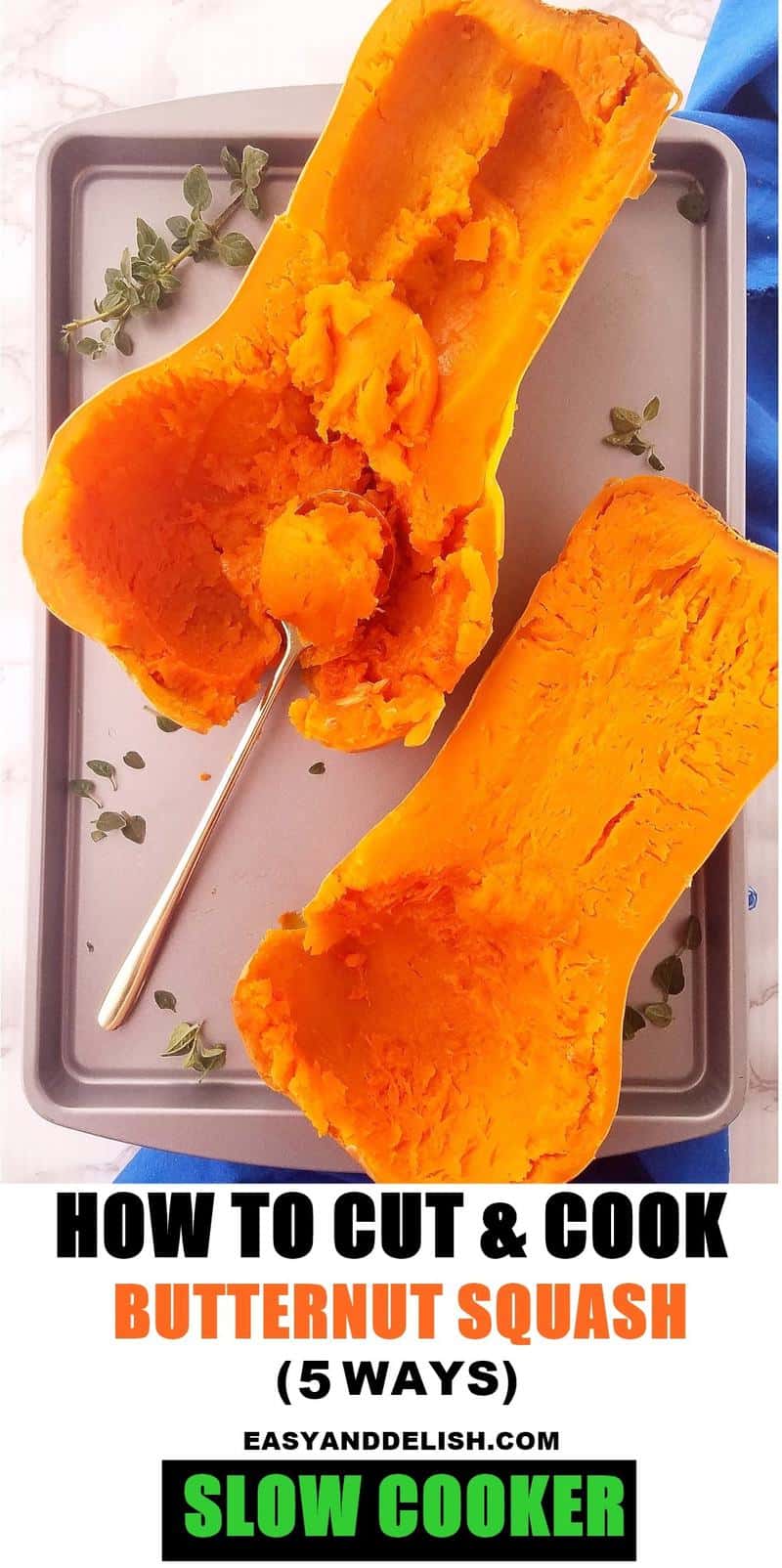
- Wash squash with a brush and pat dry. Place whole squash in the slow cooker (with or without stem), close lid, and cook on high for 4 hours or on low for 8-10 hours. There is no need to pour water in the bottom to cook it.
- Let it cool just enough to handle and cut in half lengthwise. Remove seeds and strings and then scoop out the flesh. That is how to cook butternut squash in the crockpot easily!
In the Instant Pot or pressure cooker:
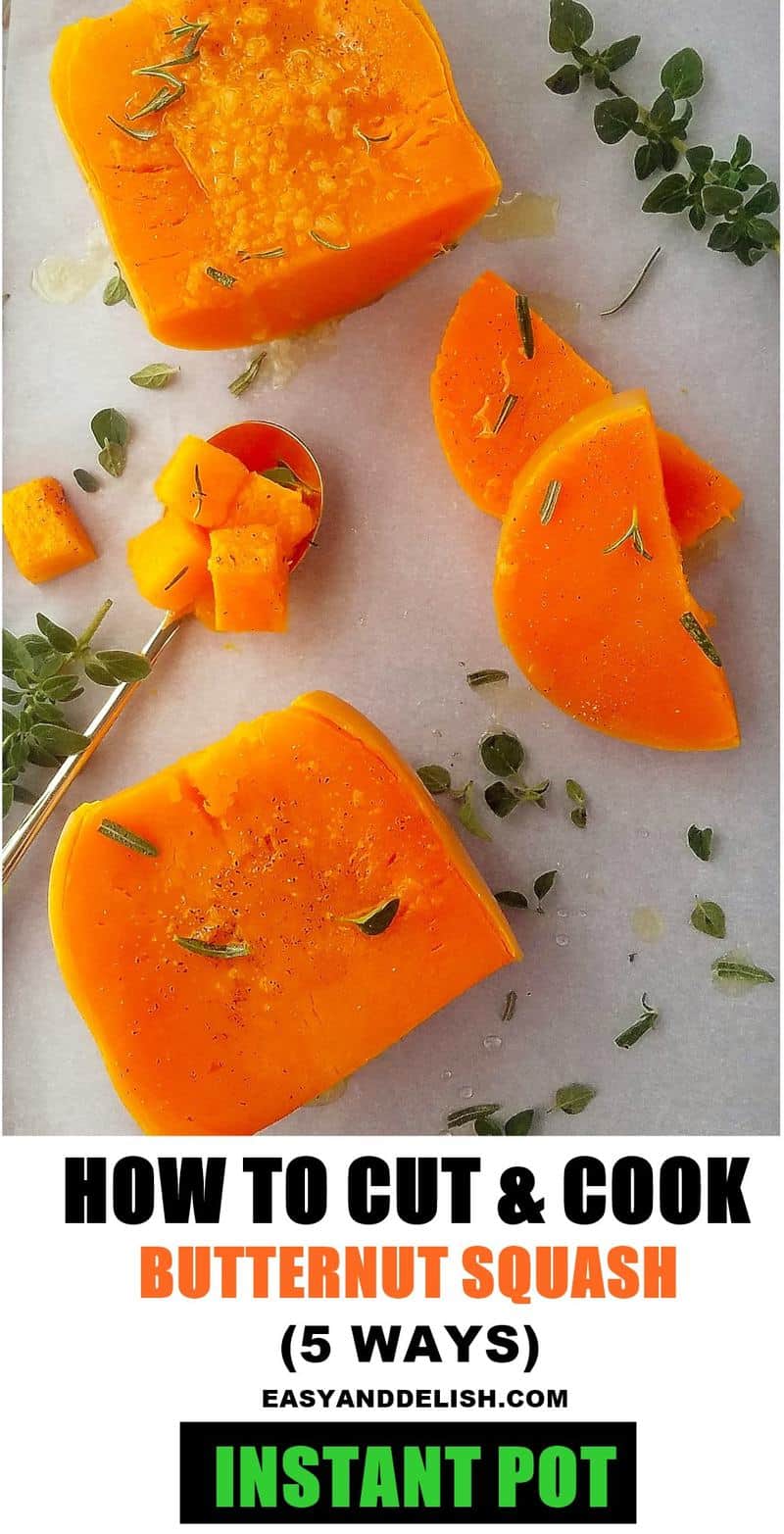
- Wash squash with a brush and pat dry. Cut off ends and then cut in half crosswise.
- Put each half upright and cut into quarters. Remove seeds and attached strings using a spoon or ice cream scoop.
- Place steam basket into the Instant Pot and pour in 1 ½ cups of water. Place squash quarters on top of the steam basket, lock the lid, secure the valve, and cook on high pressure for about 6-7 minutes. Depending on your pressure cooker, you may have to press the steam button and manually set to 6 or 7 minutes.
- Remove quarters with tongs and scoop out the flesh. To serve it as baby food, just smash or purée the cooked flesh.
Find out how to use the pressure cooker in 6 steps to cook other vegetables and also for other common food.
In the Microwave:
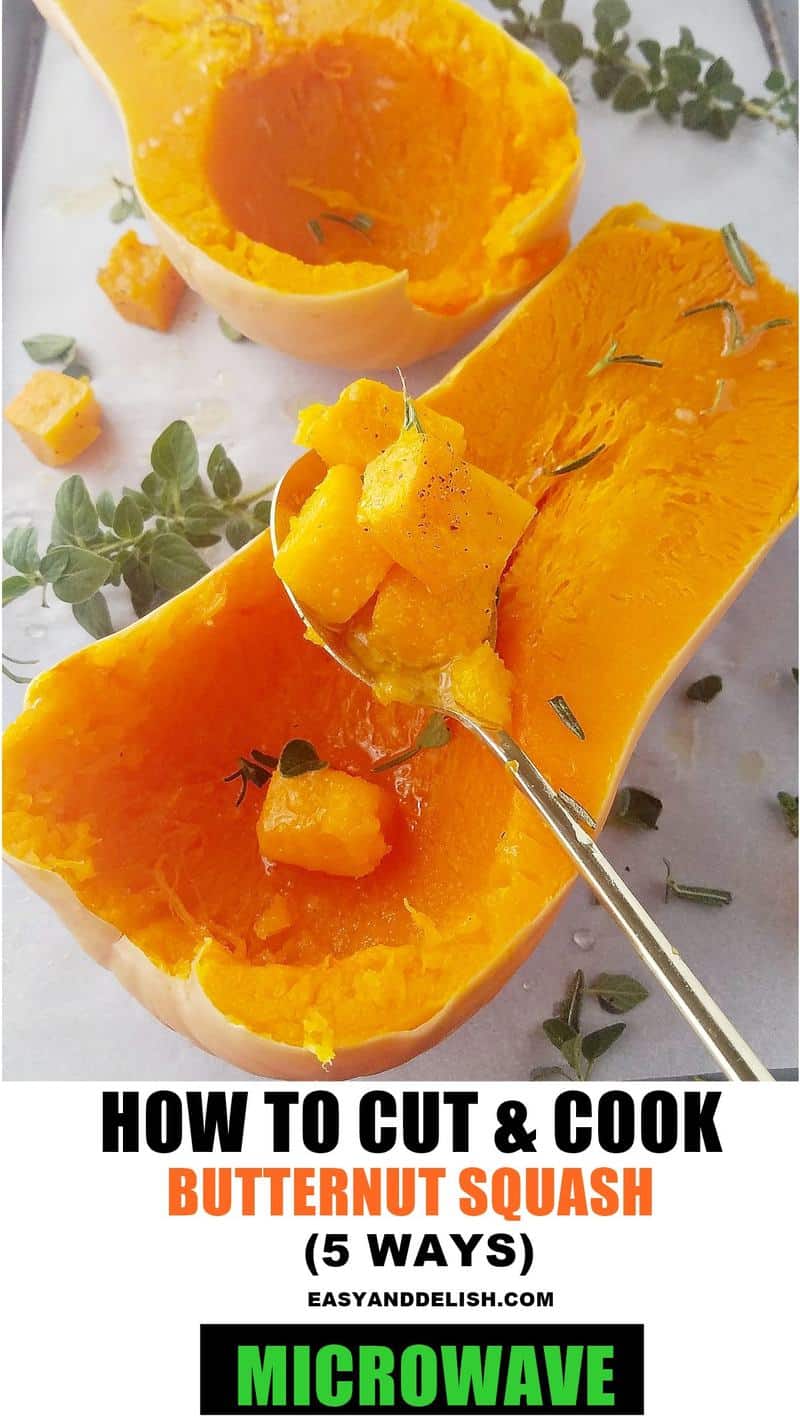
- Wash squash with a brush and pat dry. Using a paring knife, make slits around squash to vent.
- Place whole squash in a microwave-safe dish and cook for about 10-12 minutes (1200 Watt oven) or more depending on the potency of your microwave.
- Check if tender enough by pricking the cooked squash with a fork. Allow it to cool just enough to handle.
- Cut cooked butternut squash in half and remove seeds and strings with a spoon. Cut into slices or cubes, or scoop out the flesh.
Can You Eat the Skin?
Cooked butternut squash skin is edible and it contains a lot of nutrients such as fiber, vitamins, and minerals.
However, the skin may be tough to eat if the squash is old. In this case, discarding the skin is the best option! But if the squash is young, the skin is usually tender enough to eat.
What to serve with cooked squash
You can use the flesh or pulp of cooked butternut squash to make soups such as Autumn squash soup, mashed butternut squash, rolls, sweet bread, pies, cakes and muffins, and others.
When cubed and roasted, it goes well in salads or as a side for roast chicken, roast turkey, this honey baked ham, and our slow cooker ham.
Storage
If raw, uncut squash will keep well for 3-4 months if stored in a cool and dry place. Discard if it becomes soft, moldy, or squishy.
If cooked, store butternut squash in an airtight container in the fridge for 3-4 days, or a freezer bag in the freezer for up to 3-4 months. If freezing cooked and cubed squash, place the cubes on a parchment paper-lined baking sheet and freeze until solid before putting them in a bag/container. This simple step will prevent them from sticking to each other.
For More Side Dish Recipes:
- Roasted delicata squash
- Stuffed Acorn Squash
- Broccoli gratin
- Roasted carrots and parsnips
- Brussels Sprouts (6 ways)
PIN & ENJOY!
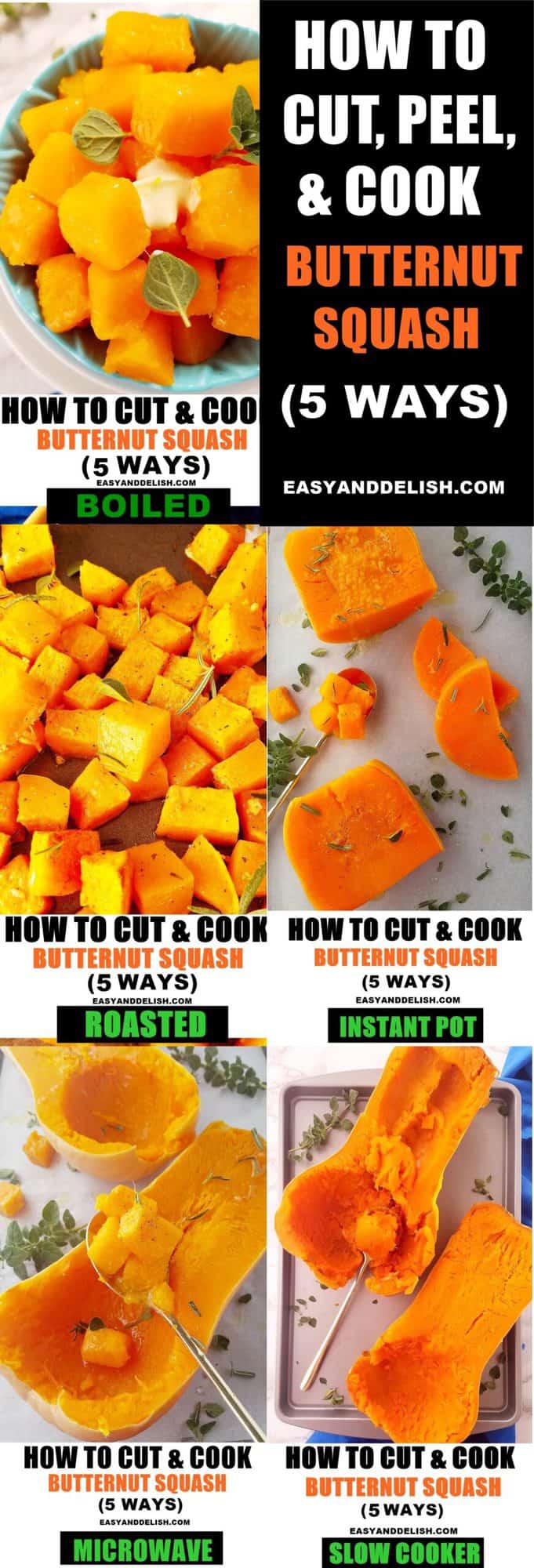
How to cook butternut squash (5 ways)
Equipment
- baking sheet, pot, microwave, Instant Pot, or slow cooker
Ingredients
Roasted:
- 3 lb butternut squash
- 2 tablespoon olive oil
- 2 garlic cloves minced
- A pinch of salt and pepper
- 2 rosemary sprigs chopped
Boiled:
- 3 lb butternut squash
- a good pinch of salt
- water enough to cover
Crockpot:
- 3 lb butternut squash
Instant Pot:
- 3 lb butternut squash
- 1 ½ cups water
Microwave:
- 3 lb butternut squash
Instructions
- Roasting: Preheat oven to 400 F (200 C). Wash squash with a brush and pat dry.
- Cut off ends and then in half crosswise. Place halves upright and peel the skin off with a vegetable peeler or a sharp knife.
- Cut squash into quarters and remove both the seeds and strings using a spoon.
- Cut into ¾ to 1–inch cubes. Place them into a bowl and mix with olive oil, garlic, rosemary, and salt and pepper until coated.
- Spread mixture into a large baking sheet (preferably lined with foil for easy cleaning).
- Roast for about 35-40 minutes or until fork-tender and caramelized.
- Boiling: Wash squash with a brush and pat dry. Cut off ends and then in half crosswise. Place halves upright and peel the skin off with a vegetable peeler or a sharp knife.
- Cut squash into quarters and remove both the seeds and strings using a spoon. Cut into ¾ to 1–inch cubes.
- Place squash in a pot and fill with enough water to cover by 1-2 inches above the squash. Season with salt and boil over high heat for about 12-15 minutes or until fork-tender.
- Drain or remove cooked squash with a slotted spoon. You may serve with butter while still hot or a hint of extra virgin olive oil.
- Crockpot: Wash squash with a brush and pat dry. Place whole squash in the slow cooker (with or without stem), close lid, and cook on high for 4 hours or on low for 8-10 hours. There is no need to pour water in the bottom to cook it.
- Let it cool just enough to handle and cut in half lengthwise. Remove seeds and strings and then scoop out the flesh. That is how to cook butternut squash in the crockpot easily!
- Instant Pot: Wash squash with a brush and pat dry. Cut off ends and then cut in half crosswise.
- Put each half upright and cut into quarters. Remove seeds and string using a spoon.
- Place steam basket into the Instant Pot and pour in 1 ½ cups of water. Place squash quarters on top of the steam basket, lock the lid, secure the valve, and cook on high pressure for about 6-7 minutes. Depending on your pressure cooker, you may have to press the steam button and manually set to 6 or 7 minutes.
- Remove quarters with tongs and scoop out the flesh. To serve it as baby food, just smash or purée the cooked flesh.
- Microwave: Wash squash with a brush and pat dry. Using a paring knife, make slits around squash to vent.
- Place whole squash in a microwave-safe dish and cook for about 10-12 minutes (1200 Watts) or more depending on the potency of your microwave.
- Check if tender enough by pricking the cooked squash with a fork. Allow it to cool just enough to handle.
- Cut cooked butternut squash in half and remove seeds and strings with a spoon. Cut into slices or cubes, or scoop out the flesh.
Recipe Video

Recipe Notes
- Wash squash thoroughly using a vegetable brush. This will help to not contaminate the vegetable peeler! Then, pat dry to keep the peeling process from getting slippery.
- Next, cut off the ends and slice the squash in half crosswise. This will allow you to place each half upright in a steady position on the cutting board.
- Using a vegetable peeler or a sharp knife, peel off all the skin.
- Cut halved squash in quarters. Then, remove both the seeds and attached strings using a spoon or ice cream scoop.
- At this point, you may cut the squash into slices or into ¾ to 1-inch cubes. Or you can cook the quarters in the Instant Pot, for example.
Nutrition
** Nutrition labels on easyanddelish.com are for educational purposes only. This info is provided as a courtesy and is only an estimate, since the nutrition content of recipes can vary based on ingredient brand or source, portion sizes, recipe changes/variations, and other factors. We suggest making your own calculations using your preferred calculator, based on which ingredients you use, or consulting with a registered dietitian to determine nutritional values more precisely.
Please note that health-focused and diet information provided on easyanddelish.com is for educational purposes and does not constitute medical advice, nor is it intended to diagnose, treat, cure, or prevent disease. Consult with your doctor or other qualified health professional prior to initiating any significant change in your diet or exercise regimen, or for any other issue necessitating medical advice.



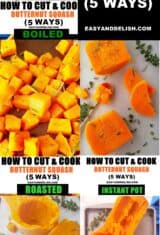
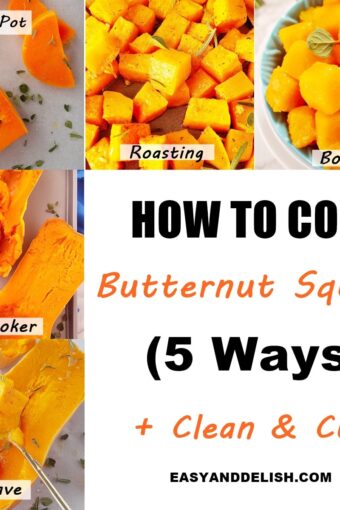
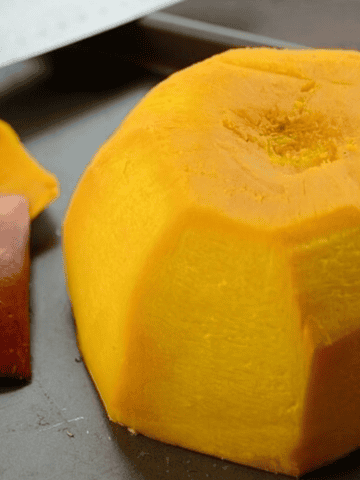
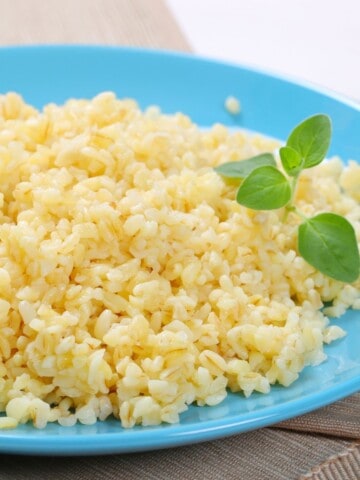

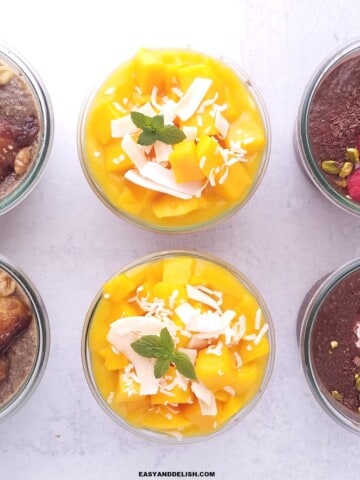
Raymund says
Great tips! I am sure the roasting would yield the most flavour
Denise Browning says
Yes, the roasted butternut squash is the most flavorful of the 5 methods.